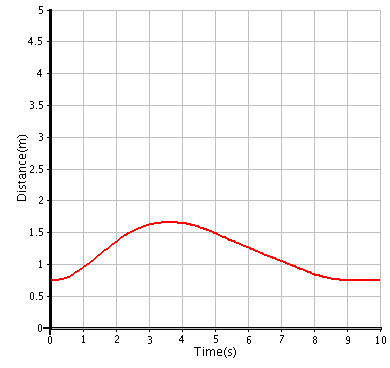Trial 1 - Messing Around
-
Before
beginning Trial 1 set up the walking track.
Refer to Technical Hints to set up the walking
track.
-
If someone is running toward you or
away from you, how could you find out how
far away he or she is at any moment without
using a meter stick or tape measure? Discuss
this question with your team and write down
some of your ideas.

-
The following motion graph of a
person walking was made with a motion
sensor. Study and discuss the motions shown
in the graph with your team and then answer
the questions below.


When does the person move forward?
How close to the motion sensor does the
student start?

-
With your back to the motion
sensor, try to reproduce the graph shown
above. Refer to Technical Hints to connect the
motion sensor. Refer to Technical Hints to record a
series of measurements. Repeat until you
reproduce the curved wave. Save the graph.
Refer to Technical Hints to save a graph.

-
Did you need to change speeds to
create the graph? Explain.

-
Try calculating the forward change
in speed of the student according to the
graph. The student moved forward 1 meter in
2 seconds before stopping. That means that
his speed was 1 meter per second or 0.5 m/s.
Verbalize in your own words how to determine
speed from a graph.

-
Now it is your turn. What was the
speed of the student when he moved
backwards? Describe your method for
determining speed.

-
Keep in mind that a positive slope
(lean of the line) results in a positive
speed. A negative slope of the line results
in a negative speed. Was the motion of the
student walking backwards, positive or
negative? Write your answer below.

Copyright 2005 The Concord Consortium, All
rights reserved.
|












